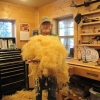In a relief carving like this there are 2 planes: a virtual one at the front - what's left of the original wood surface - and one at the back - the 'background'. You can think of them as the front and back, parallel walls of a fish tank, between which all the action takes place.
In this carving, the virtual front plane connects the prow of the boat and the rocks on the left. The back plane is the distant sky. Our subject sweeps back between the front and back plane. We need to make full use of perspective to be convincing and it will help to establish the back plane early and work forward from there.
I'll show you a quick way of removing the bulk of the waste but you can of course also carve it back: lowering with a deep gouge and levelling with a flat one.

| 08 March 2014 17:59
I don't know where to post this - here or in letter carving, but I used my only good router bit on a first letter carving gift when it wasn't going well: I "erased" the layer down to the letters' depth with this kind of drilling, chipped off the rough ages and sanded all back down. It was a good thickness of wood that is actually a better height at this point, and I practiced your technique at the same time! Really cool!!

| 23 February 2014 10:00
Ann - The one I used was about 1in. 25mm. across. I like them because they leave a flat surface with only a light centre pin hole. You do need a power drill for Forstner, they don't screw into the wood as other types of drill bit do, so a certain amount of pressure is needed; I used a drill press (pillar drill) which has a depth stop - you can limit the depth you go to - by hand, you will need to mark the depth on the drill bit itself. A good alternatibe is a 'spade' or 'flat bit', which might be easier. Some of these have long centre points, which need grinding or filing shorter to prevent them marking the background. Mmm. I'm logging this as a future lesson...

| 21 February 2014 12:45
I never would have thought of starting from the background. Interesting...

| 20 February 2014 14:06
Drilling with a fostner bit - now that sounds interesting and really useful even for "us low power tools" people. What size is it?